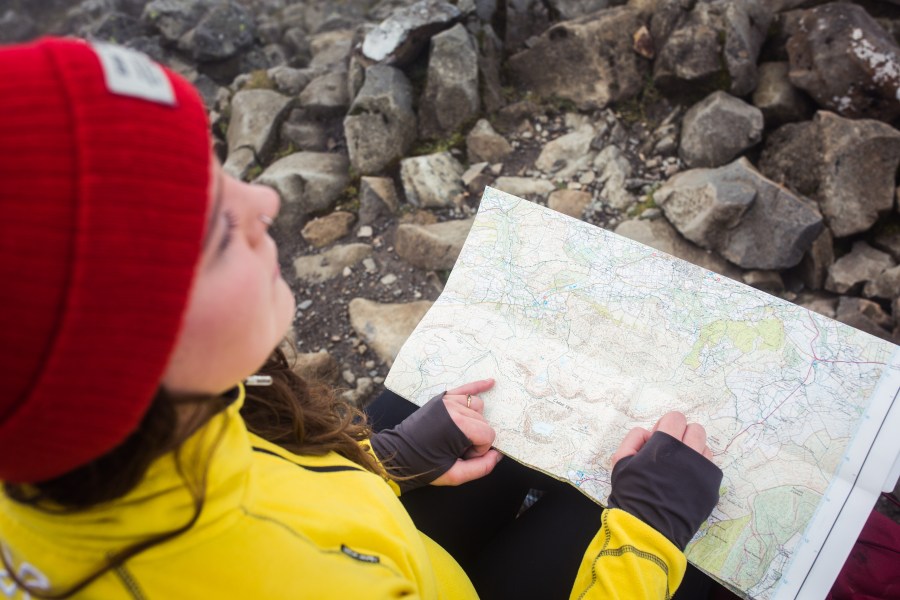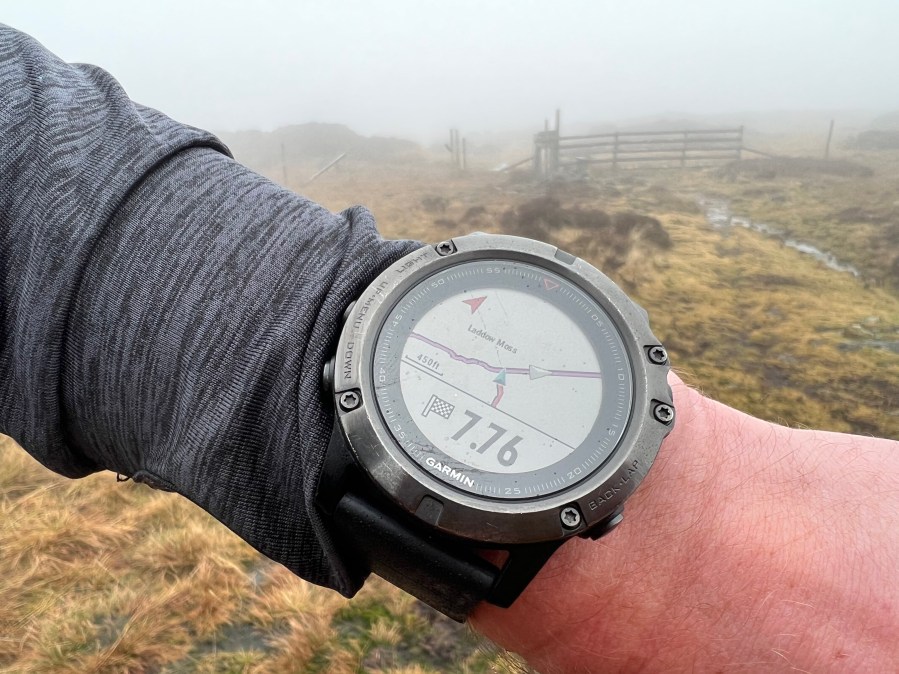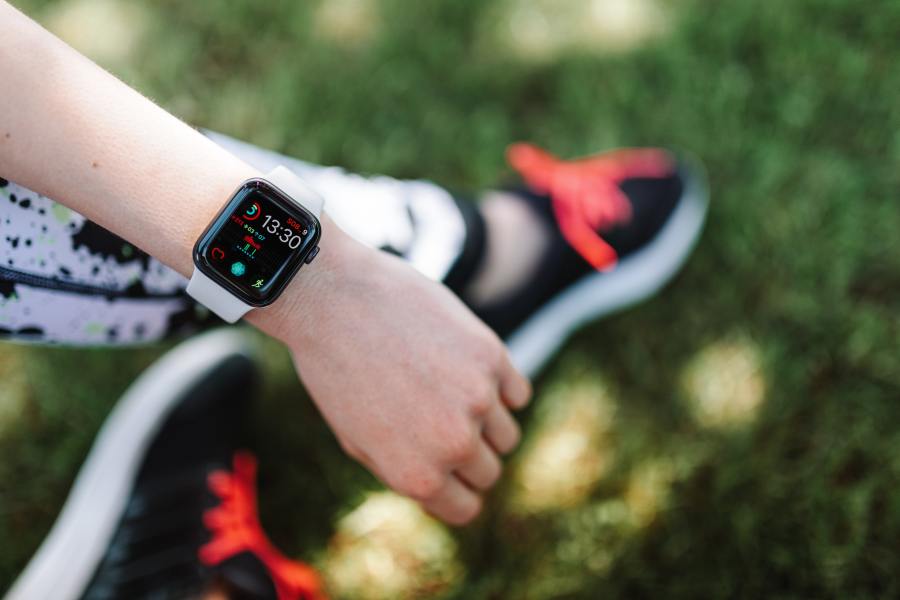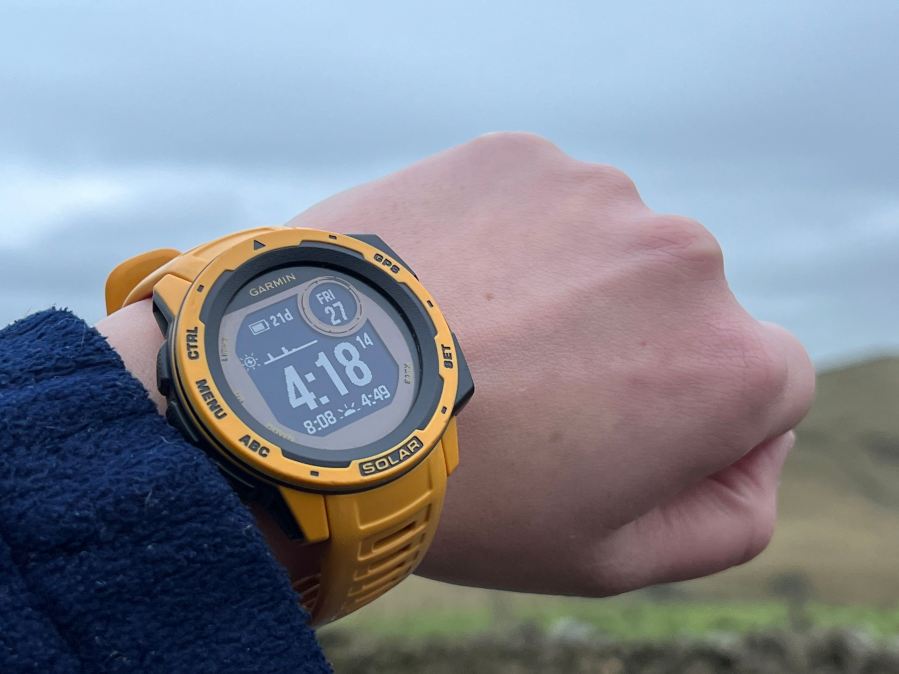As backpackers look to move faster and lighter through mountainous terrain, the popularity of wearable navigation tech such as GPS watches increases, along with innovations in the market. Not only is there jargon a-plenty, but the plethora of options can feel a bit of a minefield. And that’s before we even begin to explain how the potentially life-saving devices actually work. So, here we debunk some common misconceptions and answer your frequently asked questions about whether GPS watches need the internet and beyond in order to help you choose the right one for you.
Words: Francesca Donovan | Main image: The author using her Garmin Solar. Credit: Francesca Donovan
Your FAQs about navigation wearables
- Do GPS watches need the internet?
- Do GPS watches use data?
- Will a GPS watch keep me safe?
- Do GPS watches work in the woods?
- Do GPS watches have maps?
- Can I track my movements on my GPS watch?
- Can someone else track my movements on my GPS watch?
- What’s the difference between a GPS watch and a fitness tracker?
- Do GPS watches need a subscription?
- What is a GPS solar watch?
- Are GPS watches worth it?
- What’s the best GPS watch?
Do GPS watches need the internet?
In short, no. No GPS watches need the internet. GPS watches instead receive data to triangulate your position from a series of satellite networks that circulate above the earth. Your device calculates the time taken for radio signals from at least four different satellites to reach it and this is how it locates your position. This system does not require an internet connection or cellular service to function.
However, some smartwatches – think the Apple Watch, Samsung Galaxy Watch and Google Pixel Watch – offer a cellular connection for additional features such as making calls and sending texts. While it’s rare in outdoor GPS watches, some models such as the Garmin Forerunner 945 do include these features you’re more likely to expect from your smartphone than your GPS watch.
Do they use data?
The main features of most GPS watches – namely navigating using maps – will not use up cellular data. However, certain features such as ‘Sync My Data’ will use cellular data if a Wi-Fi connection is not present.
Will a GPS watch keep me safe?
A GPS watch should only ever be considered a backup navigational tool in the mountains. This is because tech can – albeit occasionally – let you down. Imagine if your watch malfunctioned or its battery simply died and you had no power pack to hand. Would you still be able to stay on track and safe in the hills? This is why it’s always vital to carry a map and compass – and know how to use them – when hillwalking.

A walker checking their OS Map at the summit of Cadair Idris. Credit: Jessie Leong
However, a GPS watch can offer at-a-glance reassurance of your position and direction along your route and – should the worst happen and you need assistance – most basic models can also provide grid references for emergency services.
Some GPS watches even offer additional features such as text messaging and incident alarms, which can provide great comfort, especially to solo adventurers. So while your GPS watch cannot keep you safe from harm, it can certainly help you – along with a good dose of common sense and practiced hill skills – avoid getting into trouble along the way.
Do wearables work in the woods?
The geography of mountainous and hillier areas – such as cliffs, steep slopes, deep valleys and tree cover – can sometimes cause inaccurate readings from your GPS watch and, as above, are yet another reason you shouldn’t rely solely on a GPS watch while navigating outdoors.

Setting up a woodland bivvy for the night.
Credit: Nordisk
If you are using a GPS watch, look for models that can connect to multiple satellite constellations as these will fare better in wooded areas.
Like every navigation tool, GPS does not provide a totally perfect system one hundred percent of the time and even gravity itself can pull satellites slightly out of orbit while the Earth’s atmosphere can distort radio signals. This is worth considering when you pack for your next backpacking trip.
Do GPS watches have maps?
Not all GPS watches are capable of displaying maps; typically, older or cheaper devices, for example, may simply show you a set of coordinates that you can cross-reference with a paper map. You should always check if the GPS watch you’re considering comes with in-built maps or whether these must be purchased separately as – sometimes expensive – add-ons.

Navigating with maps through the mist.
Credit: Francesca Donovan
Can I track my movements on my GPS watch?
Yes, GPS watches will allow you to track your walk and save it on the device so you can see your distance, duration and ascent. This can be transferred as a file onto another mapping tool and device so you can look at the route in full, even in 3D in some cases.
Some GPS watches will also track other everyday fitness data like steps, heart rate, calories burned and sleep quality, depending on the model and your preferences.
Can anyone else track my movements?
Yes. Some GPS watch manufacturers offer your friends and loved ones the ability – with your permission – to track your live whereabouts through their own platforms, such as LiveTrack via Garmin Connect.
It’s worth nothing that these features usually require a data connection to work, and can be unreliable in the mountains. Some Garmins can connect directly to an inReach satellite tracker to help you control tracking this way, but the watch itself requires the inReach to do this.
What’s the difference between a GPS watch and a fitness tracker?
While a basic GPS watch will track your time outdoors based on your location, and therefore the distance travelled and elevation gained over the duration, a fitness tracker focuses on the movement of your body (usually acceleration in wrist or ankle movement while walking or running) in conjunction with external fitness apps to garner data such as mileage, calories burned and heart rate.

Fitness watches are great – but they’re not designed for navigating the great outdoors.
Credit: Karolina Grabowski
A GPS watch can give you a more accurate measure of your mileage due to its focus on location but, while fitness trackers tend to be less exact, they also tend to be smaller and lighter due to smaller sensors. They may suit faster-moving athletes walking or running on less high-stakes terrain, looking for comfort over accuracy of location services.
However, if you’re an outdoor enthusiast, it’s recommended you opt for a GPS watch designed with that activity in mind. Not only do most GPS watches have great motion sensors nowadays, but some can offer further features perfect for hillwalkers such as ABC sensors (altimeter, barometer, and compass) that help with navigation and can even forecast changes in weather.
Do GPS watches need a subscription?
In terms of their basic function – namely, pinpointing your location – GPS watches don’t require a subscription or external app. In fact, many watch manufacturers have their own accompanying applications – like Garmin Connect – by which you can connect to your other devices. With that said, most also offer integration with common programs like AllTrails, Strava, OS Maps and Komoot.
However, some watches rely on external add-ons for things like topographical map layers. While some of these applications do offer free-to-use basic plans, others – such as OS Maps and Komoot – require you to pay a subscription fee for advanced features.

Some watches have solar capabilities – useful on sunnier days than this!
Credit: Francesca Donovan
What is a solar watch?
While all GPS watches are rechargeable, with varying battery capacities, some GPS watches also come with solar capabilities to boost the battery life while outdoors. This can be useful for short days in fair summertime weather. Less so in the Great British winters, of course.
Either way, solar charging will not provide a fully-charged battery and it is still always advisable to carry a power pack for your electrical items on long backpacking trips on in case of an emergency on shorter days in the hills.
Are wearables worth it?
With their location accuracy, you can certainly see why GPS watches have been welcomed into the outdoor adventure toolbox of many hillwalkers and outdoor enthusiasts – especially as many now have multi-sport capabilities.

Many GPS watches now have multi-sport capabilities.
Credit: Mali Maeder
In the hills, a GPS watch can act as a confidence boost should navigation get tough or a backup plan should other navigational tools fail. Not to mention, they’ve now become a statement of style as well as function.
However, they are expensive in comparison to the more traditional – if cumbersome – GPS handheld devices. And nothing can quite replace the reliability of a map and compass which, incidentally, remains the cheapest navigational tool out there.
If you’re on a budget, you could look to improve your own navigation skills before investing in expensive tech or look into more affordable GPS options.
What’s the best GPS watch?
Tech expert Alex Roddie has tried and tested the latest GPS watches designed to use outdoors. Read his verdict in our Buyers’ Guide to GPS Watches.
Read more: Now your FAQs on whether GPS watches need the internet and beyond are answered, learn how to use GPS watches for hiking navigation








